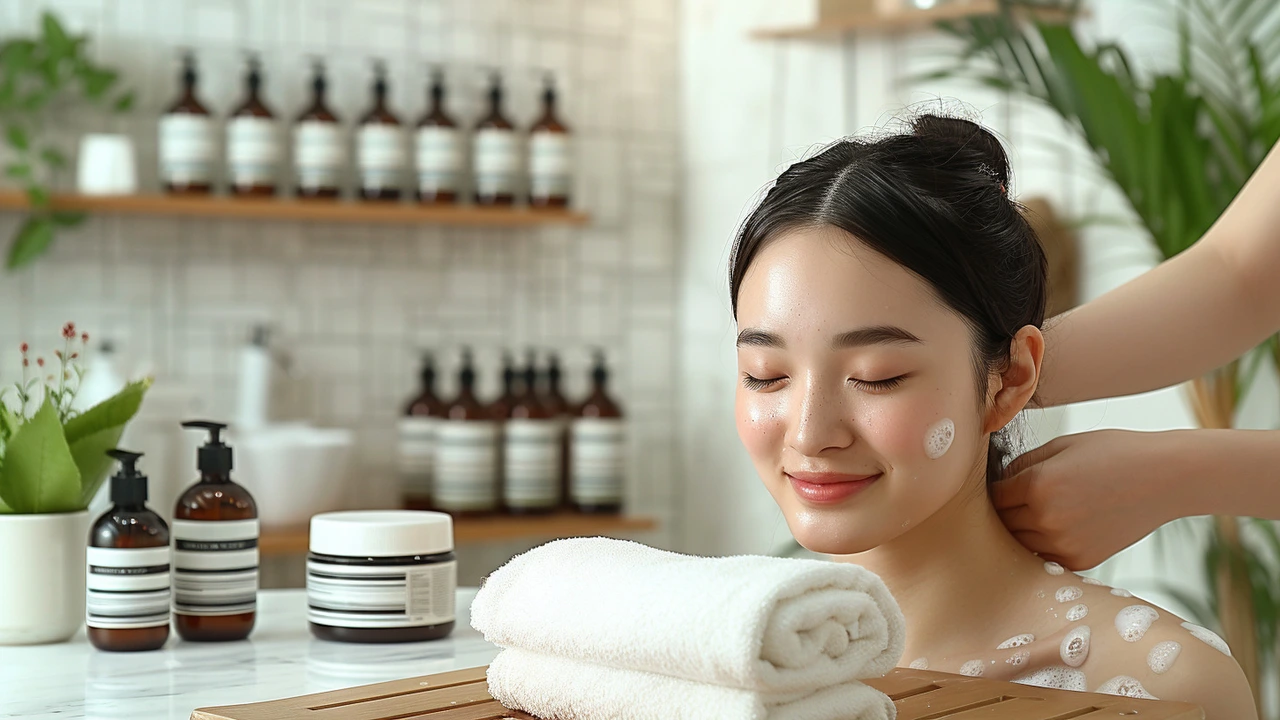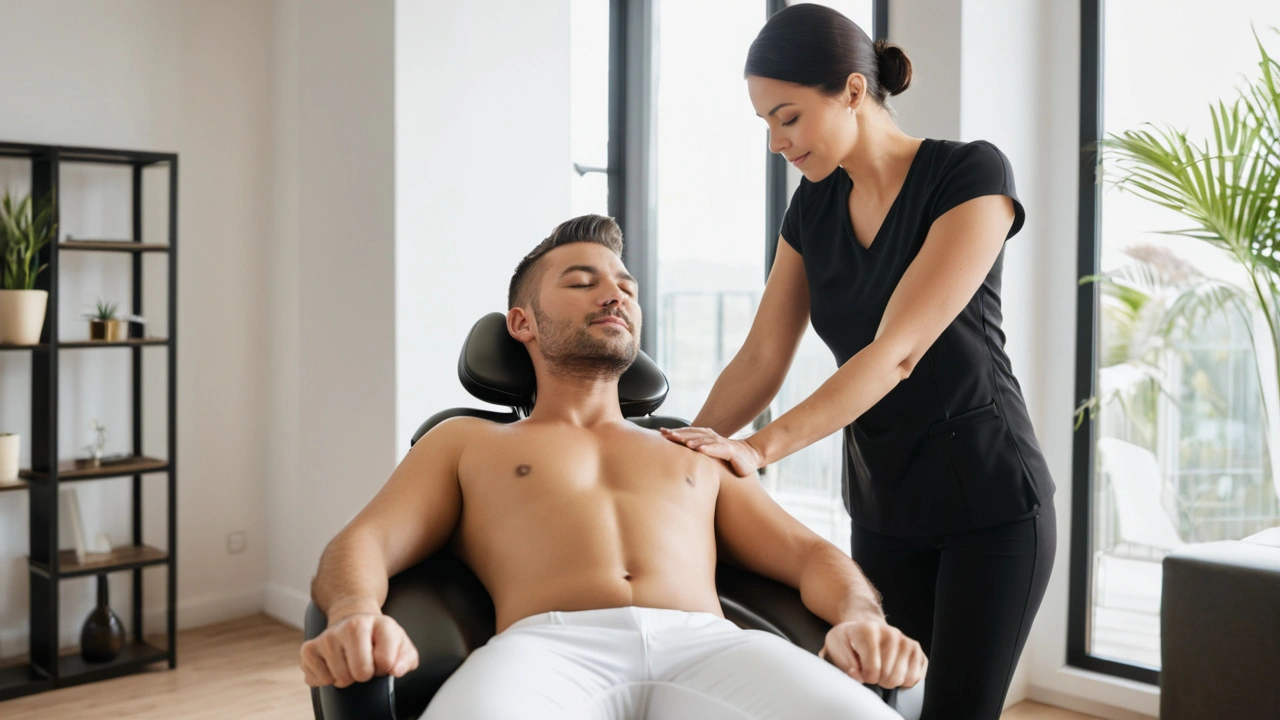The Ultimate Guide to Swedish Massage Techniques for Relaxation and Healing

Swedish massage, known for its calming and healing effects, has become increasingly popular for those seeking to improve their overall well-being. By combining gentle techniques and therapeutic touches, this form of massage offers a perfect balance of relaxation and health benefits.
This guide will delve into the basics of Swedish massage, including its history, techniques, benefits, and practical tips to make the most out of your massage experience. Whether you're new to massage therapy or a seasoned aficionado, there's something here to help you relax, heal, and rejuvenate.
- Introduction to Swedish Massage
- Historical Background
- Techniques and Methods
- Health Benefits
- Finding a Qualified Massage Therapist
- Tips for a Great Massage Experience
Introduction to Swedish Massage
Swedish massage is often considered the classic form of massage therapy that many people envision when they think of getting a professional massage. Originating in Sweden in the early 19th century, this massage technique was developed by Per Henrik Ling, who was both a fencing master and physiologist. His method was designed to promote overall health by improving circulation and relieving muscle tension, combining both physical and mental benefits.
The unique aspect of Swedish massage lies in its combination of five main techniques: effleurage (long, gliding strokes), petrissage (kneading and squeezing), friction (deep, circular movements), tapotement (rhythmic tapping), and vibration (shaking or trembling movements). When applied skillfully, these techniques work together to promote relaxation, reduce pain, and improve flexibility. One of the major goals is to direct blood flow to heart, enhancing oxygen delivery throughout the body, which can boost energy and promote recovery.
Unlike some forms of massage that might leave you feeling sore, Swedish massage is often described as relaxing and invigorating. The therapist uses oil or lotion to reduce friction on the skin, allowing for smooth, flowing movements that make the experience not only therapeutic but also deeply relaxing. Usually, sessions last between 60 to 90 minutes, providing ample time to address different parts of the body and target specific areas of tension.
Interestingly, a study published in the journal Evidence-Based Complementary and Alternative Medicine found that Swedish massage can lower cortisol levels, the hormone associated with stress, while increasing serotonin and dopamine, the hormones that promote happiness and well-being. This hormonal shift is one reason many people report feeling significantly better, both physically and mentally, after a session.
From athletes recovering from intense training sessions to office workers combating the strain of desk work, Swedish massage offers something for everyone. Whether you seek it out for relaxation, pain relief, or improved flexibility, the benefits are vast and well-documented.
According to Tiffany Field, the director of the Touch Research Institute at the University of Miami School of Medicine, 'Massage therapy has been shown to improve immune function, reduce anxiety, and alleviate symptoms of depression.'
This holistic approach makes Swedish massage not just a luxury but a valuable tool for maintaining optimal health. Knowing what to expect and understanding the techniques can help you get the most out of your experience. In the sections that follow, we will delve deeper into the history of Swedish massage, explore the various techniques in more detail, and provide tips for finding a qualified therapist to ensure you receive the best possible care.
Historical Background
The history of Swedish massage is as fascinating as the practice itself. It traces back to the early 19th century, pioneering work by Per Henrik Ling. Known as the Father of Swedish Gymnastics, Ling was not only a physical educator but also a medical researcher. His inquisitive nature and dedication to physical health led him to develop a set of massage techniques that would form the basis of Swedish massage.
Ling's methods emphasized the healing power of touch and movement, combining his background in both physical training and medicine. His work intersected with the study of anatomy, physiology, and the benefits of physical exercise. Although Ling himself did not coin the term 'Swedish massage,' his techniques laid the groundwork for future practitioners who modified and refined his original practices.
The spread of these techniques from Sweden to the rest of the world can be attributed to several key figures, including Dutch doctor Johan Georg Mezger. Mezger, often credited with establishing the foundation for modern Swedish massage, introduced terms like petrissage (kneading) and effleurage (stroking), which are still used in the language of massage therapy today.
By the late 19th century, these techniques had gained popularity across Europe and North America. They became a staple in physical therapy and general health practices, praised for their ability to enhance relaxation and improve overall health. In the words of one early advocate,
"The proper application of massage can stimulate circulation, relieve tension, and energize the entire body."
Swedish massage continued to evolve through the 20th century, with new research and clinical practices further validating its health benefits. Techniques were standardized, and the practice became more accessible to the general public. Today, Swedish massage is regarded as one of the most effective ways to improve physical health and emotional well-being.

Techniques and Methods
Swedish massage involves a series of techniques designed to improve circulation, ease muscle tension, and help the body naturally heal itself. Among the most well-known methods are effleurage, petrissage, friction, tapotement, and vibration. Each of these techniques plays a unique role in the process, ensuring a comprehensive, therapeutic experience.
The first key technique, effleurage, involves long, sweeping strokes across the muscles. The primary aim of effleurage is to warm up the muscles and prepare them for deeper work. By using gentle pressure, the therapist can help increase blood flow and promote relaxation in the recipient.
Petrissage comes next, which includes kneading, rolling, and lifting of the muscles. This technique targets the deeper layers of muscle tissue, helping to release knots and tension. By focusing on specific areas, petrissage enhances overall flexibility and alleviates chronic pain.
Friction is another essential technique in Swedish massage. It involves the application of deeper pressure in small, circular movements. Friction helps break up adhesions or scar tissue that may be causing pain or restricting movement. This method can be particularly effective for athletes or individuals recovering from injuries.
The next technique, tapotement, consists of rhythmic tapping, cupping, or pounding motions. These rapid movements help stimulate the muscles and nervous system, boosting *energy levels* and promoting a feeling of invigoration. Despite its vigorous nature, tapotement can also be quite relaxing when performed skillfully.
Vibration is the final core technique of Swedish massage. This involves gentle shaking or trembling movements that help to loosen and relax muscle tissues. Vibration can assist in releasing deeper muscle tension and improving lymphatic drainage. It is often used to help soothe and calm the body at the end of a session.
“The techniques used in Swedish massage offer a dynamic blend of relaxation and therapeutic benefits, making it one of the most sought-after forms of massage therapy.” - National Center for Complementary and Integrative Health
As you can see, each technique in Swedish massage has its own distinct purpose and benefit. Combining these methods effectively requires skill and understanding, which is why finding a qualified massage therapist is essential. A good therapist will tailor these techniques to your specific needs, ensuring you get the most out of your session.
Health Benefits
Experiencing a Swedish massage can bring about profound changes to one's health. By employing techniques such as long, gliding strokes, kneading, and circular motions, this kind of massage has numerous benefits, both physical and mental. One of its primary advantages is the reduction of stress. In our fast-paced lives, stress is a constant companion. Engaging in regular Swedish massage can lower levels of cortisol, a stress hormone, promoting a sense of calm and relaxation.
Another significant benefit is pain relief. Whether it's chronic pain from conditions like arthritis or muscle soreness from an intense workout, Swedish massage can alleviate discomfort. This is achieved by improving blood circulation, which helps deliver oxygen and nutrients to tissues and muscles, aiding in their repair and reducing pain. It's no wonder that countless people turn to this type of massage for its soothing effects on aches and pains.
Improving circulation has further health benefits. Better circulation means better oxygenation of cells, which can enhance overall energy levels and vitality. Regular sessions can help stimulate the lymphatic system, which is vital for removing toxins from the body. An efficient lymphatic system boosts the immune system, making the body more resilient against diseases and infections.
Mental health also sees significant improvements. Swedish massage can combat symptoms of depression and anxiety. The gentle, rhythmic strokes stimulate the production of endorphins, serotonin, and dopamine, chemicals in the brain that boost mood and alleviate feelings of sadness and anxiety. This mental upliftment can have a ripple effect on overall well-being, fostering a more positive outlook on life.
Flexibility is another area where Swedish massage shines. By working on muscle tension and tightness, it can improve the range of motion. This is particularly beneficial for athletes and older adults who may find their movements restricted due to stiff muscles and joints. Enhanced flexibility not only helps in daily tasks but also reduces the risk of injuries.
Enhanced sleep quality is yet another fantastic benefit. Many people suffer from insomnia or poor sleep quality due to stress and anxiety. Swedish massage helps in reducing these factors, allowing for a deeper, more restful sleep. Improved sleep, in turn, contributes to better overall health, as the body gets the time it needs to repair and rejuvenate.
According to the American Massage Therapy Association, "Regular massage can contribute to a significant decrease in cortisol levels, which helps in managing stress more effectively."
Last but not least, skin health improves. The massage oils used in Swedish massage, combined with the techniques, help in exfoliating the skin, removing dead skin cells, and promoting better hydration. This results in a more radiant and youthful appearance. Increased blood flow also means that nutrients and oxygen reach the skin more efficiently, supporting its health and glow.
To sum up, Swedish massage offers a well-rounded approach to health, melding relaxation with tangible physical and mental benefits. Whether you're dealing with stress, pain, or simply want to enhance your well-being, this type of massage provides a holistic solution.

Finding a Qualified Massage Therapist
When it comes to indulging in the soothing benefits of a Swedish massage, the qualifications and expertise of your massage therapist make a huge difference. Choosing a competent professional ensures not only a relaxing experience but also one that is safe and effective. So, where do you begin your search for the right massage therapist?
First, it's essential to check the certifications and licenses of the therapist. In many regions, therapists need to have specific state or national certifications to practice legally. Verify these credentials to ensure your therapist follows best practices. A licensed massage therapist often has extensive training and has passed rigorous exams, providing an additional layer of assurance.
Next, seek referrals and read reviews. Word of mouth is sometimes the best form of advertising. Ask friends, family members, or co-workers if they can recommend a trusted therapist. Alternatively, online reviews on platforms such as Yelp or Google can provide useful insights. Pay attention to comments about the therapist’s professionalism, skill level, and how comfortable clients felt during their sessions.
According to the American Massage Therapy Association, “Finding a qualified massage therapist enhances your health benefits and ensures a safe and effective session.”
Additionally, consider the therapist’s experience with the type of massage you want. Swedish massage is quite popular, but not all therapists specialize in it. You might come across therapists who focus on sports massage, deep tissue massage, or other modalities. Ask about their specific training and experience with Swedish massage to ensure you are getting an expert in that field.
Don't underestimate the importance of a consultation session. Many therapists offer an initial meeting or phone call to discuss your needs, any medical conditions, and what you hope to achieve from the massage. This interaction can help you gauge whether the therapist is a good fit for you. They should ask about your medical history and listen to your concerns to tailor the therapy according to your needs.
It's also essential to observe the hygiene and environment of the massage clinic. A clean and calm setting is indicative of a well-maintained and professional practice. Look for indicators such as fresh linens, clean massage tables, and an overall atmosphere conducive to relaxation and healing.
Price is another consideration, albeit not the most critical one. While it might be tempting to opt for the cheapest option, remember that quality and expertise often come at a price. Investing in a qualified therapist may cost more upfront but can lead to better health outcomes and a more enjoyable experience.
Lastly, trust your instincts. It's vital that you feel comfortable and safe with your massage therapist. If something feels off during your initial consultation or session, don’t hesitate to try someone else. Your comfort and well-being should always come first.
Tips for a Great Massage Experience
Having an exceptional massage is an experience you won't forget, but getting the most out of it involves a bit of preparation and knowledge. First, make sure to communicate openly with your massage therapist. Sharing any specific areas of tension or discomfort helps tailor the massage to your needs. Honesty about your medical history and any current conditions is also important. Effective communication ensures a safe and beneficial session.
Hydration is another key factor. Drink plenty of water both before and after your massage. Staying hydrated helps to flush out the toxins released during the muscle manipulation. Also, arrive on time to your appointment, or even a few minutes early. This allows you to start relaxing before the massage begins, rather than rushing and feeling stressed from the start.
Your attire matters too. Wear loose, comfortable clothing to your session. Although you'll be undressed to your comfort level for the massage, leaving in relaxed attire will continue the soothing effects. Don't forget about your state of mind. Entering the session with a calm and open attitude can significantly enhance the experience.
After the massage, take some time to rest and let your body adjust. The effects of a Swedish massage can linger, so give your body the chance to fully benefit. Remember to take it easy and avoid any strenuous activities or heavy lifting right after your session.
Consider regular massages as part of your health routine. One massage can work wonders, but frequency can lead to more sustained benefits. Research indicates that regular massage therapy can reduce stress, improve sleep, and even support the immune system. According to a 2023 study published in the Journal of Alternative and Complementary Medicine, participants who received bi-weekly massages reported significant decreases in anxiety and muscle tension compared to those who did not.
Lastly, don't overlook the post-session feedback. If there's something you particularly enjoyed or didn't like, let your therapist know. This information helps improve future sessions. Building a rapport and understanding your therapist's style and technique preferences can enhance your upcoming experiences.
By keeping these tips in mind, you're setting yourself up for a truly great Swedish massage experience. Embrace the relaxation and healing benefits, ensuring each session contributes meaningfully to your overall well-being.





